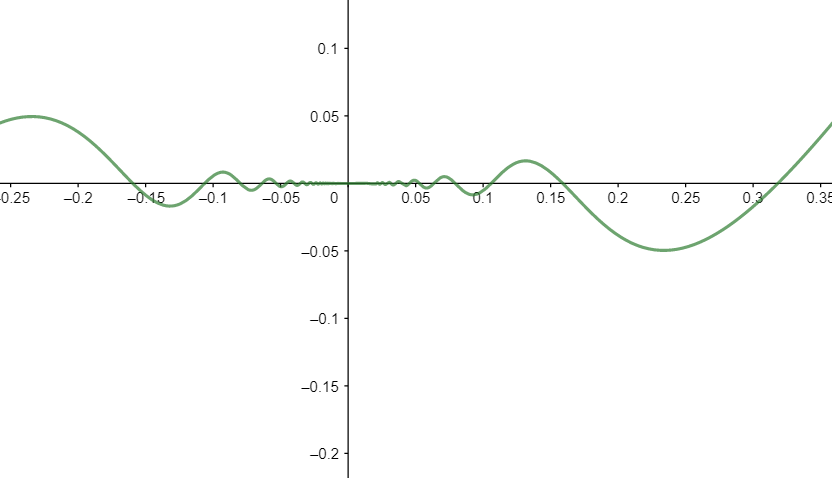
Discuss the continuity of the function $f\left( x \right)=\left\{ \begin{matrix}
{{x}^{2}}\sin \left( \dfrac{1}{x} \right),x\ne 0 \\
0,\text{ }x=0 \\
\end{matrix} \right.$ at x=0.
Answer
595.2k+ views
Hint: Use the fact that if a function f(x) is continuous at a point, then the left hand limit and the right hand limit at that point are equal and are equal to the value of the function at that point. Hence, we have $f\left( x \right)$ is continuous at x= a if $\underset{x\to {{a}^{-}}}{\mathop{\lim }}\,f\left( x \right)=\underset{x\to {{a}^{+}}}{\mathop{\lim }}\,f\left( x \right)=f\left( a \right)$. Hence find the left hand limit and the right hand limit at x= 0. Verify if the limits are equal or not. Check if the limits are equal and are they equal to the functional value and hence verify whether f(x) is continuous at x =0. Use the fact that $\underset{x\to 0}{\mathop{\lim }}\,x\sin \left( \dfrac{1}{x} \right)=0$ and use \[\underset{x\to {{a}^{-}}}{\mathop{\lim }}\,f\left( x \right)=\underset{h\to 0}{\mathop{\lim }}\,f\left( a-h \right)\] and $\underset{x\to {{a}^{+}}}{\mathop{\lim }}\,f\left( x \right)=\underset{h\to 0}{\mathop{\lim }}\,f\left( a+h \right)$ and hence find LHL and RHL.
Complete step-by-step answer:
We have $f\left( x \right)=\left\{ \begin{matrix}
{{x}^{2}}\sin \left( \dfrac{1}{x} \right),x\ne 0 \\
0,\text{ }x=0 \\
\end{matrix} \right.$
Now, we have
LHL $=\underset{x\to {{0}^{-}}}{\mathop{\lim }}\,f\left( x \right)=\underset{h\to 0}{\mathop{\lim }}\,f\left( 0-h \right)$
Hence, we have
LHL $=\underset{h\to 0}{\mathop{\lim }}\,f\left( -h \right)=\underset{h\to 0}{\mathop{\lim }}\,{{\left( -h \right)}^{2}}\sin \left( \dfrac{-1}{h} \right)=\underset{h\to 0}{\mathop{\lim }}\,{{h}^{2}}\sin \left( \dfrac{-1}{h} \right)$
We know that $\underset{h\to 0}{\mathop{\lim }}\,h\sin \left( \dfrac{1}{h} \right)=0$
Hence, we have LHL $=\underset{h\to 0}{\mathop{\lim }}\,\left( -h \right)\underset{h\to 0}{\mathop{\lim }}\,h\sin \left( \dfrac{1}{h} \right)=0\times 0=0$
Now, RHL $=\underset{x\to {{0}^{+}}}{\mathop{\lim }}\,f\left( x \right)=\underset{h\to 0}{\mathop{\lim }}\,f\left( 0+h \right)$
Hence, we have
RHL $=\underset{h\to 0}{\mathop{\lim }}\,f\left( h \right)=\underset{h\to 0}{\mathop{\lim }}\,{{h}^{2}}\sin \left( \dfrac{1}{h} \right)$
We know that $\underset{h\to 0}{\mathop{\lim }}\,h\sin \left( \dfrac{1}{h} \right)=0$
Hence, we have RHL $=\underset{h\to 0}{\mathop{\lim }}\,h\times \underset{h\to 0}{\mathop{\lim }}\,h\sin \left( \dfrac{1}{h} \right)=0\times 0=0$
Hence LHL = RHL = 0.
Also f(0) = 0.
Hence, we have
LHL = RHL = f(0).
Hence, the function is continuous at x=0.
Note: Graph of f(x):

As can be seen from the graph of f(x), f(x) is continuous at x=0.
[2] Alternative solution:
We know that if f(x) is continuous at x =a, then $\forall \varepsilon >0$ there exists $\delta >0$ such that $\left| f\left( x \right)-f\left( a \right) \right|<\varepsilon $, whenever $\left| x-a \right|<\delta $.
We have $f\left( x \right)=\left\{ \begin{matrix}
{{x}^{2}}\sin \left( \dfrac{1}{x} \right),x\ne 0 \\
0,\text{ }x=0 \\
\end{matrix} \right.$
Claim: f(x) is continuous at x=0.
We have $\left| f\left( x \right)-f\left( a \right) \right|=\left| {{x}^{2}}\sin \left( \dfrac{1}{x} \right)-0 \right|=\left| {{x}^{2}}\sin \left( \dfrac{1}{x} \right) \right|$
Since $\sin \left( \dfrac{1}{x} \right)\le 1$, we have $\left| {{x}^{2}}\sin \left( \dfrac{1}{x} \right) \right|\le \left| {{x}^{2}} \right|\le {{\left| x \right|}^{2}}$.
Hence $\forall \varepsilon >0\exists \delta =\sqrt{\varepsilon }>0$ such that whenever $\left| x-0 \right|<\delta \Rightarrow \left| {{x}^{2}} \right|<\varepsilon \Rightarrow \left| {{x}^{2}}\sin \left( \dfrac{1}{x} \right)-0 \right|<\varepsilon $.
Hence f(x) is continuous at x= 0.
Complete step-by-step answer:
We have $f\left( x \right)=\left\{ \begin{matrix}
{{x}^{2}}\sin \left( \dfrac{1}{x} \right),x\ne 0 \\
0,\text{ }x=0 \\
\end{matrix} \right.$
Now, we have
LHL $=\underset{x\to {{0}^{-}}}{\mathop{\lim }}\,f\left( x \right)=\underset{h\to 0}{\mathop{\lim }}\,f\left( 0-h \right)$
Hence, we have
LHL $=\underset{h\to 0}{\mathop{\lim }}\,f\left( -h \right)=\underset{h\to 0}{\mathop{\lim }}\,{{\left( -h \right)}^{2}}\sin \left( \dfrac{-1}{h} \right)=\underset{h\to 0}{\mathop{\lim }}\,{{h}^{2}}\sin \left( \dfrac{-1}{h} \right)$
We know that $\underset{h\to 0}{\mathop{\lim }}\,h\sin \left( \dfrac{1}{h} \right)=0$
Hence, we have LHL $=\underset{h\to 0}{\mathop{\lim }}\,\left( -h \right)\underset{h\to 0}{\mathop{\lim }}\,h\sin \left( \dfrac{1}{h} \right)=0\times 0=0$
Now, RHL $=\underset{x\to {{0}^{+}}}{\mathop{\lim }}\,f\left( x \right)=\underset{h\to 0}{\mathop{\lim }}\,f\left( 0+h \right)$
Hence, we have
RHL $=\underset{h\to 0}{\mathop{\lim }}\,f\left( h \right)=\underset{h\to 0}{\mathop{\lim }}\,{{h}^{2}}\sin \left( \dfrac{1}{h} \right)$
We know that $\underset{h\to 0}{\mathop{\lim }}\,h\sin \left( \dfrac{1}{h} \right)=0$
Hence, we have RHL $=\underset{h\to 0}{\mathop{\lim }}\,h\times \underset{h\to 0}{\mathop{\lim }}\,h\sin \left( \dfrac{1}{h} \right)=0\times 0=0$
Hence LHL = RHL = 0.
Also f(0) = 0.
Hence, we have
LHL = RHL = f(0).
Hence, the function is continuous at x=0.
Note: Graph of f(x):

As can be seen from the graph of f(x), f(x) is continuous at x=0.
[2] Alternative solution:
We know that if f(x) is continuous at x =a, then $\forall \varepsilon >0$ there exists $\delta >0$ such that $\left| f\left( x \right)-f\left( a \right) \right|<\varepsilon $, whenever $\left| x-a \right|<\delta $.
We have $f\left( x \right)=\left\{ \begin{matrix}
{{x}^{2}}\sin \left( \dfrac{1}{x} \right),x\ne 0 \\
0,\text{ }x=0 \\
\end{matrix} \right.$
Claim: f(x) is continuous at x=0.
We have $\left| f\left( x \right)-f\left( a \right) \right|=\left| {{x}^{2}}\sin \left( \dfrac{1}{x} \right)-0 \right|=\left| {{x}^{2}}\sin \left( \dfrac{1}{x} \right) \right|$
Since $\sin \left( \dfrac{1}{x} \right)\le 1$, we have $\left| {{x}^{2}}\sin \left( \dfrac{1}{x} \right) \right|\le \left| {{x}^{2}} \right|\le {{\left| x \right|}^{2}}$.
Hence $\forall \varepsilon >0\exists \delta =\sqrt{\varepsilon }>0$ such that whenever $\left| x-0 \right|<\delta \Rightarrow \left| {{x}^{2}} \right|<\varepsilon \Rightarrow \left| {{x}^{2}}\sin \left( \dfrac{1}{x} \right)-0 \right|<\varepsilon $.
Hence f(x) is continuous at x= 0.
Recently Updated Pages
Why is there a time difference of about 5 hours between class 10 social science CBSE

In cricket, what is a "pink ball" primarily used for?

In cricket, what is the "new ball" phase?

In cricket, what is a "death over"?

What is the "Powerplay" in T20 cricket?

In cricket, what is a "super over"?

Trending doubts
What is meant by exothermic and endothermic reactions class 11 chemistry CBSE

Which animal has three hearts class 11 biology CBSE

10 examples of friction in our daily life

One Metric ton is equal to kg A 10000 B 1000 C 100 class 11 physics CBSE

1 Quintal is equal to a 110 kg b 10 kg c 100kg d 1000 class 11 physics CBSE

Difference Between Prokaryotic Cells and Eukaryotic Cells




